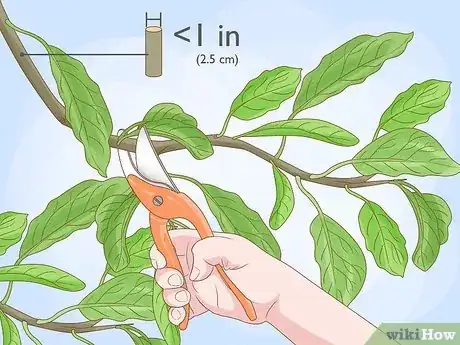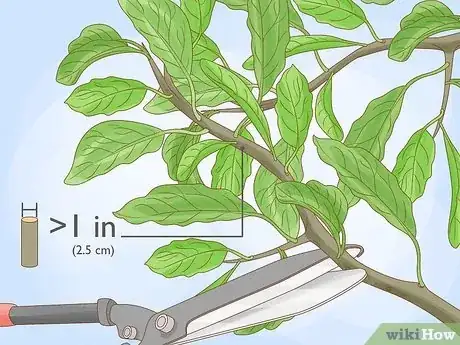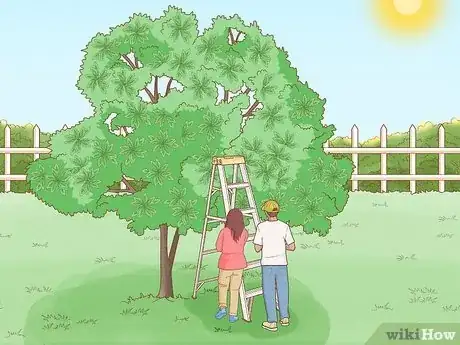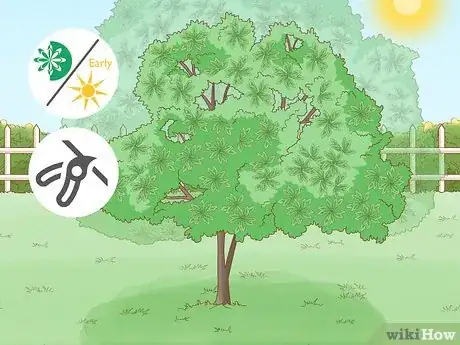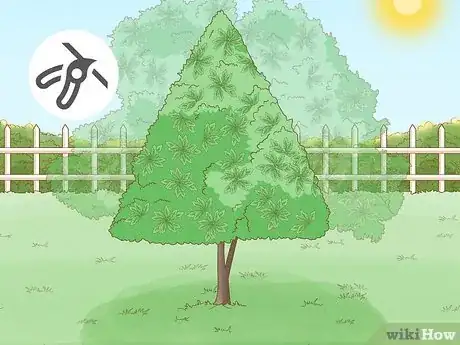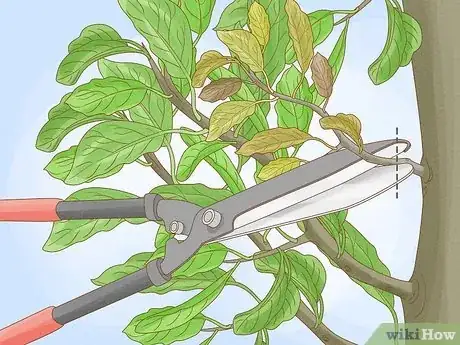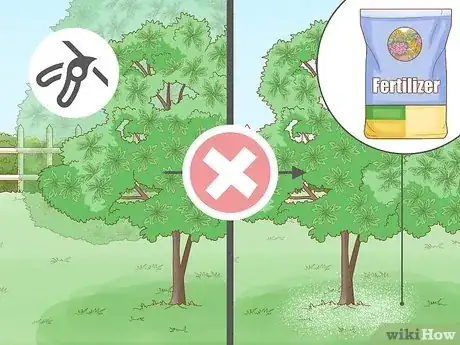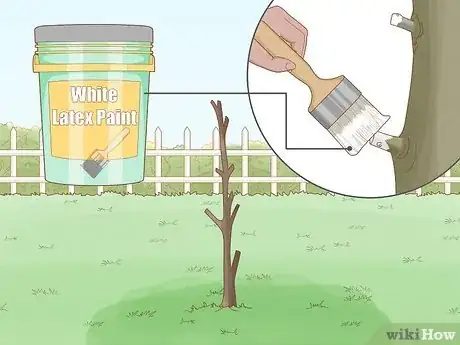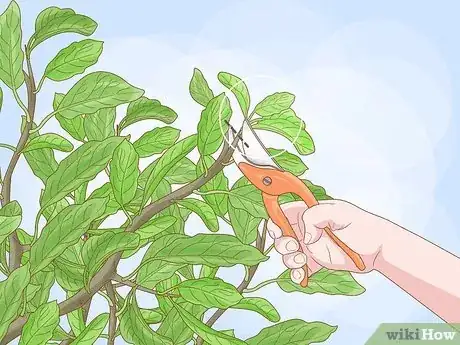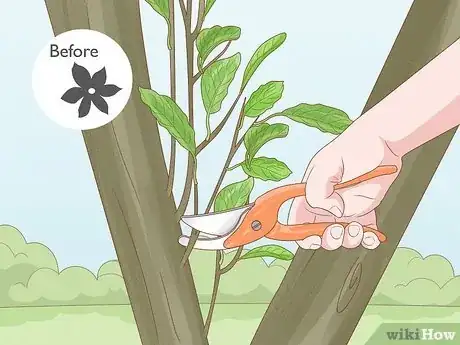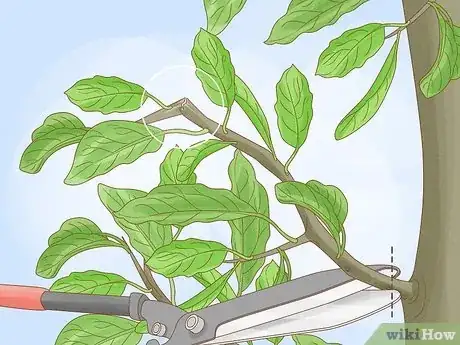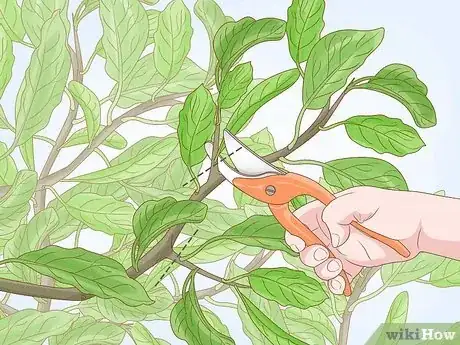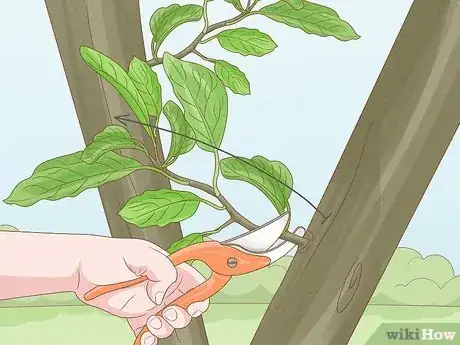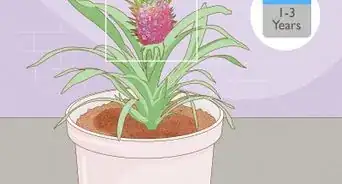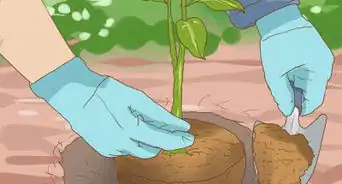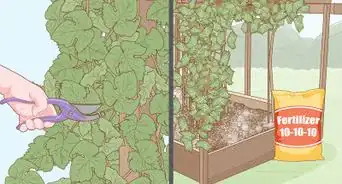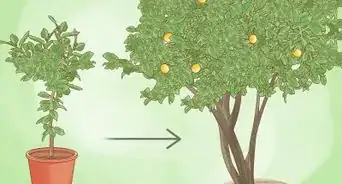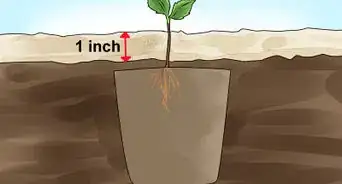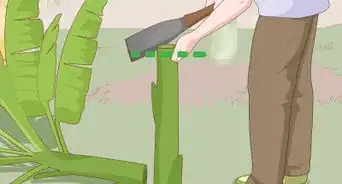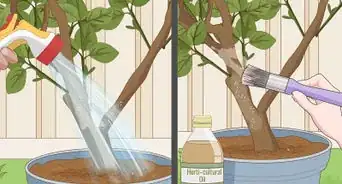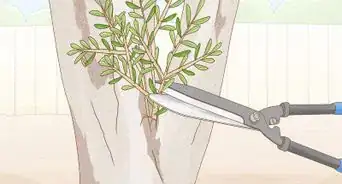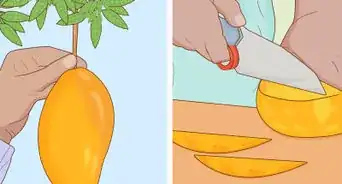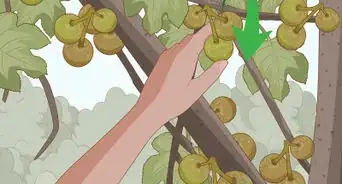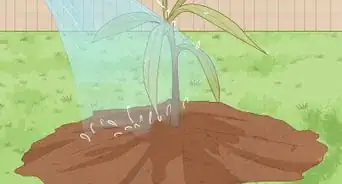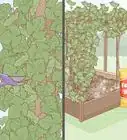This article was co-authored by Lauren Kurtz. Lauren Kurtz is a Naturalist and Horticultural Specialist. Lauren has worked for Aurora, Colorado managing the Water-Wise Garden at Aurora Municipal Center for the Water Conservation Department. She earned a BA in Environmental and Sustainability Studies from Western Michigan University in 2014.
There are 12 references cited in this article, which can be found at the bottom of the page.
wikiHow marks an article as reader-approved once it receives enough positive feedback. In this case, 100% of readers who voted found the article helpful, earning it our reader-approved status.
This article has been viewed 77,762 times.
Because avocado trees need lots of foliage to ensure a high amount of fruit, they don’t need a lot of pruning. However, your tree may need some minimal pruning to maintain easy tree access, balance, and enough sun exposure. If your tree needs major re-shaping, some heavy pruning may be necessary. To prevent shock and the spread of blights, always prune during early spring or summer and wash your tools between pruning different trees. With proper care and minimal pruning, your avocado tree can thrive and keep producing fruit for years to come!
Steps
Choosing Pruning Tools
-
1Use hand pruners for branches less than 1 inch (2.5 cm) in diameter. These tools are smaller and can typically handle smaller growths. Hand pruners are perfect for removing smaller branches in the tree’s canopy to let the sun shine through.[1]
- You could also use specialty hand pruners made specifically for avocado trees, which have rounded tips to keep from damaging any of the fruit.
-
2Choose loppers to cut any branches thicker than 1 inch (2.5 cm). Loppers are perfect for removing large branches, particularly at the base of the tree.[2] These tools often go dull easily, so sharpen your loppers often and make sure they’re sharp before you start pruning.
- Make any major cuts clean and keep them in line with the natural contour of the trunk.[3]
Advertisement -
3Protect your skin with gloves, casual clothes, and a sun hat or visor. Before you start pruning, put on some comfortable, casual clothes that you don’t mind getting dirty. Add a wide-brimmed hat to keep the sun off your face and neck.
- For example, you could wear a long-sleeved T-shirt, some old jeans, sneakers, and a wide-brimmed straw hat.
-
4Take a sturdy ladder with you for easier access to the tree. Use a tall, secure ladder with a firm base, and have someone hold it while you work if you need the extra stabilization. A ladder is especially essential for pruning newly planted trees, which have shallow root systems that can’t balance out accelerated growth at the top of the tree.
-
5Gather your pruning tools before you begin. To cut down on trips back and forth from your garage or tool shed and the tree, pull out all the supplies you’ll need first. For example, you’ll need a bottle of Lysol spray, hand pruners, and loppers.
-
6Spray your tools with a disinfectant to keep from spreading insects or disease. Pruning tools like pruners and loppers can carry insects, fungus, and bacteria between trees, so it’s essential to clean them between each pruning.[4] Fill a spray bottle with a disinfectant spray, like diluted bleach or rubbing alcohol, and keep it with you to spray down and disinfect the tools before moving on to the next tree.[5]
Pruning Heavily in Spring and Summer
-
1Prune heavily only during spring or early summer to prevent shock. Cutting back during fall or winter weather could expose the avocado tree to cold temperatures and frost, so it’s important to prune in warmer temperatures. The optimum times are the first few weeks of spring or summer.[6]
-
2
-
3Re-shape the sides of the tree if it becomes too wide. Re-shaping is essential if the tree's branches start tangling with another's, or if the branches are blocking you from irrigating and mowing the area.Use loppers to cut away wild side branches if the tree’s growth gets out of hand. Focus on smaller branches, pruning several on each side, and only prune 1 major branch per year.[13]
- Aim for a symmetrical conical shape, which provides the best amount of sun exposure.
- Re-shaping will likely make fruit yield drop drastically that year, but it should stimulate fruit growth in 2 years.
- Remember to be extremely careful with this kind of heavy pruning! If you prune too much, you can permanently stunt the tree’s fruit growth.
-
4Aim for balance and symmetry when you’re pruning. Keep track of how many branches you remove from each side and mirror your cuts on the other side of the tree as well. It’s important to prune the sides of the tree symmetrically, making identical cuts to either side, to balance the tree’s weight.[14]
- For example, if you prune several branches on one side of the tree, it may stunt fruit growth on that side. When the fruit grows, the tree’s weight will be unevenly balanced and make it more susceptible to strong wind and harsh weather.[15]
-
5Remove branches at the top of the tree to control its height. Use your loppers to trim back the top slowly, removing only 1 major branch per summer, starting with the tallest.[16] This is especially important for newly planted trees, which don’t have a strong enough root system to support extra height.[17]
- Be extra vigilant with trees purchased from nurseries, which will likely have a good deal of the roots removed.
- This process may take 3-4 years to complete, but the slow and steady approach will help reduce stress on the tree.[18]
-
6Cut away any dead branches at their base. Use your pruners or loppers to cut away dead branches just above their connection to the trunk, or the branch collar. This will direct the tree's nutrients to the healthy limbs and promote new growth.
- Although it may be tempting to cut away dead wood at any time of the year, remember that frost damage can sometimes make a branch look dead. Wait for the new growth to begin in spring or summer before determining whether or not the branch needs to be pruned.[19]
-
7
-
8Cut the tree back to its main trunk if it needs rejuvenation pruning. This is an extreme, risky form of pruning, usually used in orchards to promote new growth in later years. Use your loppers to cut all of the branches back to the main trunk, clipping them at the raised ring, or the branch collar, at their base.
- If you live in a particularly sunny area, paint a thin layer of white latex paint diluted with water over the cuts to protect them from sun exposure.[22]
- Avocado trees usually take 3 years to grow and produce fruit again after rejuvenation pruning.[23]
- Since this type of pruning can permanently damage or kill your tree, it is not recommended for beginners. Unless you have experience with avocado trees, have your rejuvenation pruning done by a professional service.
Using Preventive Pruning Year-Round
-
1Use preventive pruning often to reduce the need for major pruning. Use your hand pruners ot cut away any growing tips in areas where you don’t want new branches. Since heavy pruning tends to lower the fruit yield and make the tree just grow back faster, frequent thinning cuts are a much better way to keep the avocado tree’s growth in check.[24]
- You can perform light preventive pruning any time of the year.[25]
-
2Remove water shoots to prevent imbalances. Before the tree flowers in the spring, use your hand pruners to trim away any water shoots at their base.[26] These vigorous, leafy shoots grow vertically in the bark and pruning them helps keep the tree’s growth lateral and controlled, rather than wild and untamed.[27]
-
3Fix small limb breakages by cutting away the branch at its base. If your branches have been broken by the weight of their fruit or a strong wind, you should remove them completely. Use your loppers or hand pruners to cut away any small broken branches at their base. This will help redirect nutrients to the rest of the tree and encourage branch regrowth[28]
-
4Control wild growth by using thinning cuts. In any areas of the tree that tend to grow quickly and get out of hand, prune smaller branches back to their main subtending branches. These “thinning cuts” will help keep the tree’s growth in check and prevent wild growth in the future.[29]
-
5Nip minor issues in the bud so they don’t become major problems. If you spot any wild branches starting to form, such as at the top or low to the ground on the sides, it’s much easier to cut them with loppers or pruners while they’re still small. Waiting until they’ve grown will make the pruning process more difficult and can potentially cause the tree more stress.
- For example, watch for horizontal branches forming close to the ground. These branches will grow to block your access at the base of the tree, so cut these back at their base as soon as possible.[30]
Community Q&A
-
QuestionShould I paint the exposed area of the cut tree branch?
 Community AnswerNo. There is no real reason to do this. Most people find it helpful to cut off a dead branch and give it time to grow back.
Community AnswerNo. There is no real reason to do this. Most people find it helpful to cut off a dead branch and give it time to grow back. -
QuestionDo you need two avocado trees in order to get avocados? (To pollinate.)
 Lia 💖Community AnswerTo ensure good yields of fruit, two avocado trees are required. Both flower types produce and are receptive to pollen at different times of day, so when avocado cultivars A and B are planted together, the pollination and fruit set is optimal.
Lia 💖Community AnswerTo ensure good yields of fruit, two avocado trees are required. Both flower types produce and are receptive to pollen at different times of day, so when avocado cultivars A and B are planted together, the pollination and fruit set is optimal.
Warnings
- Expect lots of leaf growth and less avocado fruit following an extensive pruning session.⧼thumbs_response⧽
- Pruning will likely reduce your tree’s fruit output for the year, but increase fruit output for the next year.⧼thumbs_response⧽
- Remember that less pruning is always better for avocado trees. If you’re not sure if your tree needs any pruning, err on the side of caution and avoid pruning.⧼thumbs_response⧽
- Never over-prune your avocado trees. Over-pruning can lead to stunting, losing all of the fruit, frost injuries, or sun damage.⧼thumbs_response⧽
- When pruning your trees, always wear gardening gloves or wash your hands thoroughly after pruning.⧼thumbs_response⧽
References
- ↑ http://www.treeremoval.com/trimming-and-pruning/how-to-grow-and-prune-an-avocado-tree/#.WjcxWiPMzPA
- ↑ http://www.treeremoval.com/trimming-and-pruning/how-to-grow-and-prune-an-avocado-tree/#.WjcxWiPMzPA
- ↑ http://www.californiaavocadogrowers.com/cultural-management-library/avocado-tree-pruning-basics
- ↑ http://www.treeremoval.com/trimming-and-pruning/how-to-grow-and-prune-an-avocado-tree/#.WjcxWiPMzPA
- ↑ https://davesgarden.com/guides/articles/view/903
- ↑ http://www.treeremoval.com/trimming-and-pruning/how-to-grow-and-prune-an-avocado-tree/#.WjcxWiPMzPA
- ↑ http://www.californiaavocadogrowers.com/cultural-management-library/deciding-when-prune-avocado-trees
- ↑ http://www.californiaavocadogrowers.com/cultural-management-library/deciding-when-prune-avocado-trees
- ↑ http://www.treeremoval.com/trimming-and-pruning/how-to-grow-and-prune-an-avocado-tree/#.WjcxWiPMzPA
- ↑ http://www.californiaavocadogrowers.com/cultural-management-library/avocado-tree-pruning-basics
- ↑ http://lee.ifas.ufl.edu/AgNatRes/Pubs/Pruning_Avocado_trees.pdf
- ↑ http://www.californiaavocadogrowers.com/cultural-management-library/avocado-tree-pruning-basics
- ↑ http://www.avocadosource.com/CAS_Yearbooks/CAS_46_1962/CAS_1962_PG_42-43.pdf
- ↑ http://www.treeremoval.com/trimming-and-pruning/how-to-grow-and-prune-an-avocado-tree/#.WjcxWiPMzPA
- ↑ http://www.treeremoval.com/trimming-and-pruning/how-to-grow-and-prune-an-avocado-tree/#.WjcxWiPMzPA
- ↑ http://ucanr.edu/blogs/blogcore/postdetail.cfm?postnum=12051
- ↑ http://lee.ifas.ufl.edu/AgNatRes/Pubs/Pruning_Avocado_trees.pdf
- ↑ http://ucanr.edu/blogs/blogcore/postdetail.cfm?postnum=12051
- ↑ http://lee.ifas.ufl.edu/AgNatRes/Pubs/Pruning_Avocado_trees.pdf
- ↑ http://www.groworganic.com/organic-gardening/articles/when-and-how-to-fertilize-your-fruit-trees
- ↑ https://www.logees.com/howtogrowavocados
- ↑ http://ucanr.edu/blogs/blogcore/postdetail.cfm?postnum=12051
- ↑ http://mimiavocado.com/2012/04/why-we-cut-the-trees-down-avocado-trees-can-regrow/
- ↑ http://lee.ifas.ufl.edu/AgNatRes/Pubs/Pruning_Avocado_trees.pdf
- ↑ http://ucanr.edu/blogs/blogcore/postdetail.cfm?postnum=12051
- ↑ http://www.hgtv.com/outdoors/gardens/planting-and-maintenance/tree-pruning-removing-water-shoots-and-suckers
- ↑ http://ucanr.edu/blogs/blogcore/postdetail.cfm?postnum=12051
- ↑ http://homeguides.sfgate.com/fruit-tree-limb-damage-repair-60821.html
- ↑ http://ucanr.edu/blogs/blogcore/postdetail.cfm?postnum=12051
- ↑ http://www.californiaavocadogrowers.com/cultural-management-library/avocado-tree-pruning-basics
About This Article
Fortunately, your avocado tree won’t require much maintenance, but you’ll still want to prune it during growing season to keep it in shape. Prune your tree during the spring or early summer when its branches will grow back healthy. Use pruners or loppers to cut any dead-looking branches. You should also cut a few branches from the canopy to ensure sunlight can get through to the rest of the tree. If your tree is getting too wide, trim a few branches back from the sides to keep it under control. Keep an eye on how many branches you prune from each side and try to keep it symmetrical so your tree isn’t too heavy on one side. For more tips from our Gardening co-author, including how to prune your avocado tree for rejuvenation, read on!
